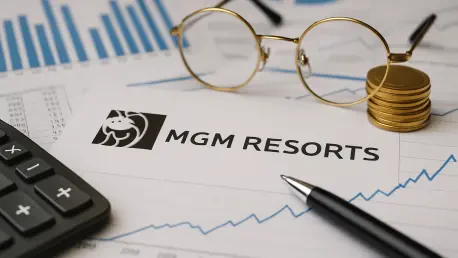In a financial landscape marked by both progress and setbacks, MGM Resorts International has unveiled its third-quarter results, painting a picture of resilience amid significant challenges that test the company’s strategic direction. The company reported a commendable revenue increase of 2%, reaching consolidated net revenues of $4.3 billion, a clear sign of strength in certain segments of its global operations. However, this positive momentum was overshadowed by a substantial net loss of $285 million, a sharp decline from the $185 million net income recorded in the same period last year. This downturn stems largely from non-cash impairment charges and operational hurdles, raising questions about the balance between growth and profitability. As the hospitality and gaming giant navigates a complex market environment, these results highlight the intricate interplay of international success and domestic struggles, setting the stage for a deeper examination of its performance across key regions and strategic initiatives.
Las Vegas Strip: A Struggle for Stability
The Las Vegas Strip, often considered the heartbeat of MGM Resorts’ domestic operations, faced a challenging third quarter with net revenues declining by 7% to $2 billion, down from $2.1 billion in the prior year. Several factors contributed to this downturn, including the ongoing room remodel at MGM Grand Las Vegas, which temporarily disrupted occupancy and revenue streams. Additionally, a drop in Revenue Per Available Room (RevPAR) and lower table games win percentages further strained financial performance. Reduced food and beverage income compounded these issues, reflecting broader softness in consumer spending or shifts in visitor preferences. The segment’s adjusted EBITDAR also took a significant hit, falling 18% to $601 million, influenced not only by the revenue decline but also by a $14 million reduction in business interruption proceeds and a $13 million rise in insurance expenses for general liability and workers’ compensation claims, painting a picture of operational strain in a critical market.
Despite the setbacks on the Las Vegas Strip, there are glimmers of hope signaling potential recovery in the near future. Chief Financial Officer Jonathan Halkyard expressed cautious optimism, pointing to emerging signs of stability in this iconic market. The return of group and convention business, a vital driver of revenue, is beginning to bolster performance as corporate events and large gatherings regain momentum. Furthermore, the completion of the MGM Grand remodel is expected to enhance guest experiences and attract higher occupancy rates, potentially reversing some of the revenue declines. These developments suggest that while the current quarter reflects significant challenges, strategic investments and market trends could pave the way for a rebound. The focus remains on adapting to evolving consumer behaviors and leveraging Las Vegas’ unique appeal as a global entertainment hub to restore financial vigor in this flagship segment.
Regional and International Performance: A Mixed Outlook
Turning to regional operations, MGM Resorts exhibited a more stable performance, with net revenues edging up slightly to $957 million from $952 million in the previous year. This incremental growth indicates a degree of resilience in markets outside the Las Vegas Strip, where localized demand and operational consistency have helped maintain a steady revenue base. However, profitability faced marginal pressure, as adjusted EBITDAR for the segment dipped by 1% to $296 million. This subtle decline suggests that while revenue holds firm, underlying costs or competitive dynamics may be eroding margins. The regional segment’s performance underscores the importance of diversified operations, providing a buffer against the more pronounced struggles in high-profile markets like Las Vegas, though it also highlights the need for cost management and targeted growth strategies to sustain long-term profitability.
On the international front, MGM China emerged as a standout performer, delivering record third-quarter results that significantly contributed to the company’s overall revenue growth. This success reflects robust demand in the Asian market, where gaming and hospitality sectors continue to thrive. Meanwhile, the BetMGM North American venture reported accelerated growth, prompting an upward revision of full-year guidance for the second consecutive quarter. CEO Bill Hornbuckle emphasized this momentum, noting that BetMGM is poised to begin cash distributions to MGM Resorts in the fourth quarter, with an initial payout expected to be at least $100 million. This development signals improved profitability and cash flow generation in the online betting space, positioning BetMGM as a key growth driver. The contrast between international strength and domestic challenges illustrates the diverse dynamics shaping MGM’s global portfolio.
Strategic Moves and Financial Health: Charting the Path Forward
Strategically, MGM Resorts made a significant decision to sell the operations of MGM Northfield Park at a strong valuation multiple, as highlighted by CFO Jonathan Halkyard. This divestiture aligns with a broader focus on premium, market-leading integrated resort operations, aiming to streamline the portfolio and prioritize high-growth areas such as MGM China and BetMGM. The move also reflects an intent to capitalize on perceived value gaps in equity pricing, potentially unlocking capital for reinvestment or debt reduction. Such portfolio optimization underscores a proactive approach to navigating financial complexities, balancing the need for operational focus with the pursuit of emerging opportunities in both traditional and digital gaming spaces, while addressing the impact of one-time charges like the $256 million non-cash goodwill impairment tied to Empire City.
Reflecting on the third quarter, the financial narrative for MGM Resorts was one of contrasts, with a revenue uptick driven by international prowess but profitability marred by a $285 million net loss and $93 million in additional non-cash write-offs. Consolidated adjusted EBITDA also declined to $506 million from $574 million year-over-year, encapsulating the operational and strategic challenges faced. Looking ahead, the path forward involves capitalizing on stability in Las Vegas through completed renovations and convention business, while leaning on international growth and digital ventures like BetMGM for momentum. Leadership’s cautious optimism suggests a commitment to refining the business model, with divestitures and targeted investments likely to shape the next quarters. Stakeholders should monitor how these strategies unfold, as they hold the key to balancing short-term impairments with long-term value creation in a competitive industry landscape.









